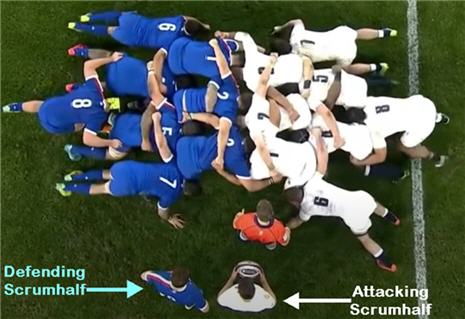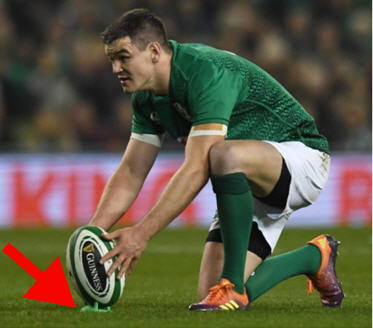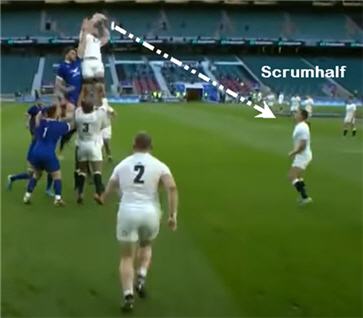Many Rugby Union clubs play one version of the sport during the regular competitive season and another during summer.
You may have caught sight of Rugby Sevens during the Summer Olympics. This is actually the less well-known and less widely played version. It’s also a little younger historically.
For convenience in this article, I’ll refer to the younger sport as “Sevens”. I’ll refer to the other sport as “Rugby” or sometimes “Fifteens”. That distinction brings us to the first difference between the sports.
[1] Number of Players In Sevens Versus Fifteens Rugby
Let’s address the obvious difference quickly: the number of players on the field and the bench is completely different.
A rugby match has fifteen players per team on the field, with each team having eight substitutes on the bench.
Sevens rugby teams put seven players on the field, with five substitutes on the bench. In major competitions, only three of the five substitutes can take to the field.
There are variations in the number of substitutes at lower levels of competition. Some sevens tournaments will allow unlimited rolling substitutions.
It would be unusual for a referee to allow a Fifteens
We have a full article that breaks down the current and historic number of rugby players per team.
[2] Differences Between Match Times, Half Time, And Extra Time
A Sevens game is much shorter than Fifteens. The shorter duration goes for the half-time break and other areas of time-keeping. Here’s a breakdown:
| Fifteens | Sevens | |
| Half | 40 minutes | 7 minutes |
| Half Time Break | 15 minutes | 1-2 minutes |
| Extra Time Half | 10 minutes | 5 minutes (sudden death) |
| Yellow Card | 10 minutes | 2 minutes |
Extra time in Sevens is on a Sudden Death basis. When a team scores, the game is over. As long as there isn’t a score, the halves continue on a five-minute basis.
You can read more details in this article on extra time in rugby, and this article on time-keeping in Sevens.
[3] Scrum Differences Between Sevens And Fifteens Rugby
Most things in Sevens are a reduced version of Fifteens. The scrum follows along these lines.
The three forwards on a Sevens rugby team participate in the scrum. In contrast, the eight forwards in Fifteens usually pack down against each other.
Here’s a picture of a Sevens scrum. If you want to know more, check out our article on props in Sevens.

Scrums in fifteens rugby
Scrums in fifteens rugby usually have eight players in each opposing pack. The scrumhalves stand close the the players packing down.
Here is an example from an international match:

Exceptions occur when a forward is sent off with a yellow or red card.
Coaches in fifteens rugby have a big tactical decision to make if they are down a forward for a scrum. They can choose to let their team scrimmage with seven versus eight players.
The danger is that the stronger opposition team will push them back and win either the ball or a penalty.
The alternative is to put a back into the back row of the scrum to achieve parity in numbers. Of course, the coach has shifted the danger from the scrum to wider out in the field.
You can learn more in our article on how many players are in a rugby scrum.
Both scrums can be contested
A Sevens scrum is less likely to be contested in the same way as in Fifteens where the packs try to push each other backward.
Many Sevens teams use the tactic of getting the ball away from the scrum as quickly as possible.
However, that doesn’t mean that Sevens scrums cannot be contested. It’s rare to see a team win the scrum “against the head” i.e. win the opposition put-in.
But teams can try to “spoil” the opposition set-piece through pushing and pulling. This can disrupt the scrum-half from getting the ball away cleanly.
[4] No Rolling Mauls In Sevens
A rolling maul in Fifteens is when three or more players move forward with the ball while grabbing hold of each other. The group tries to use their combined strength and momentum to trundle up the field.
If it’s your own team with the ball, you’re on your feet yelling with every inch gained. If it’s the opposition team, you’re telling the person beside you that mauls are a blight on the sport!
There are plenty of people who love Fifteens but who think the rolling maul should be booted out of the game.
The main argument is that all those bodies in front of the ball mean that it’s not a fair contest for possession.
I won’t get into the debate here. I’ll simply mention that rolling mauls aren’t allowed in Sevens rugby.
[5] No Place Kicks In Sevens
Players in both sports can kick for points after a try or a penalty kick is awarded.
The other type of scoring by a kick is achieved by dropping the ball from your hand and kicking it immediately. This is called a drop goal.
A place kick is different because you place the ball on the ground and kick it while it’s stationary. Modern Fifteens kickers usually use a kicking tee. This is a small plastic cup that holds the ball upright.
Here’s Ireland’s outhalf Jonathan Sexton placing the ball on a kicking tee. He’s carefully lining up the ball with the goal posts.

In earlier times before kicking tees, the Fifteens kicker would spend a bit of time digging his heel into the ground to form a little hole.
There was also a period when the kicker would carefully sculpt a little pile of sand into a nesting place.
Sevens rugby does not allow place kicks. Sevens players kick scores through drop goals.
[6] Restarting After A Score
A big difference between Fifteens and Sevens occurs when points are scored.
In Fifteens, the opposition gets possession of the ball. They restart the game through a kick-off from the halfway line.
The opposite occurs in Sevens. The team that scored retain possession of the ball. They also restart through a kick-off from the halfway line.
[7] Throwing Into The Lineout
Both rugby codes have contested lineouts. The major difference is in who is throwing in the ball to the forwards.
In the screenshot below, the England hooker (wearing the number two jersey) has just thrown the ball into the lineout.

There’s no law in Fifteens rugby that says the hooker has to throw into the lineout. In older periods, the winger used to throw in the ball.
However, you’ll rarely see any Fifteens player other than the hooker take the role. The exception is if the hooker has been carded. Another player has to step in to do the job.
I sometimes see one of the props take over when the hooker is unavailable. Adult props may have played hooker at youth level, and will occasionally practice the skill for this eventuality.
What about sevens?
There’s also no law in Sevens rugby about who throws the ball in.
In the modern game, the scrum-half often throws in the ball.
If you’re used to Fifteens, you may now be wondering – if the scrum-half throws into the lineout, then who gathers the ball when the jumpers catch it?
The answer is…the scrum-half. He or she throws the ball in and then runs into a position to receive it.
It’s an amazing sequence of skill and timing. Check out our article on the roles of scrum-halves in Sevens. It has a video showing how it’s done at the top level.
[8] Tournament Structure
Back in the amateur days of Fifteens rugby, a top-class player might tog out for their small local club on a Saturday and play for their major regional club on a Sunday.
Because it is a heavy contact sport, this is no longer considered acceptable for the health of Fifteens players.
And no tournament in Fifteens will schedule a team to play matches with less than a two or three-day turnaround between fixtures.
In contrast, Sevens tournaments are usually played over two or three days. With a two-day tournament, teams will play three fixtures on each day.
[9] Top National Teams
The International Olympic Committee decided to include Sevens instead of Fifteens as a new Olympic sport in Rio 2016.
It’s possible that the reduced number of players was part of the decision. In other words, the tournament didn’t have to cram an extra twelve squads of at least thirty players into the mix.
But the primary reason may be that some of the smaller less economically-developed countries have a successful tradition in Sevens.

The Fiji men’s Sevens team successfully defended their Olympic title in 2021, to cement their place as a powerhouse in the sport.
I compiled the rankings in the table below in the summer of 2021. The developing countries are highlighted.
As you can see, two of the top ten strongest countries in Sevens are developing countries. In contrast, no developing country is in the top ten in Fifteens.
| Place | Fifteens | Seven |
| 1 | South Africa | FIJI |
| 2 | New Zealand | USA |
| 3 | England | New Zealand |
| 4 | Ireland | South Africa |
| 5 | France | England |
| 6 | Australia | SAMOA |
| 7 | Argentina | Australia |
| 8 | Scotland | France |
| 9 | Wales | Argentina |
| 10 | Japan | Scotland |
| 11 | Fiji | Canada |
| 12 | Georgia | Spain |
| 13 | SAMOA | KENYA |
| 14 | Italy | Wales |
| 15 | Tonga | Japan |
| 16 | USA | China |
| 17 | Uruguay | TONGA |